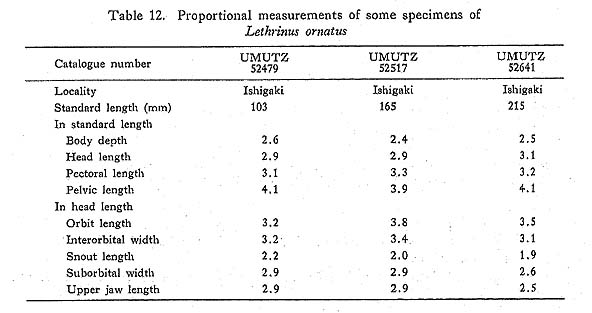V. DESCRIPTIONS
12. Lethrinus ornatus Valenciennes
12. Lethrinus ornatus Valenciennes |
 Plate 5 |
Lethrinus ornatus Valenciennes in Cuvier & Valenciennes, 1830: 310, Java; Day, 1875-89: 137, India; Bleeker, 1873a: 335, type of L. xanthotaenia; 1876-77: 119, pl. 350, fig. 4, East Indies; Day, 1889: 40, Andamans, Malay Archipel.; Herre & Montalban, 1927: 422, pl. 9, fig. 1, Philippines; Weber & Beaufort, 1936: 447, fig. 90, a Bleeker's specimen; Shinohara. 1963: 44, fig. 7, Ryukyus; Taylor, 1964: 211, Arnhem Land; Munro, 1967: 329, pl. 43, New Guinea; Sato, 1971: 135, fig. 8, Ryukyus, Philippines; Gushiken, 1972: 38, fig. 183, Okinawa Is.; Masuda et al., 1975: 60, fig. C, 234, southern Japan.
Lethrinus xanthotaenia Bleeker, 1851a: 176, West Sumatra; Güher, 1859: 461, Java, Sumatra.
Specimens examined.
Holotype. —RMNH-D442 (D, 194 mm standard length) from Java.
Syntypes of L. xanthotaenia. —RMNH5762 (2 of 38 individuals: 59, 67) from West Sumatra.
RMNH5762 (5 of 38: 178, 196, 202, 212, 230) from East Indies.
UMUTZ42232 (105) from Philippines.
UMUTZ52479 (103), 52478 (110), 52505 (116), 52517 (165), 52428 (195), 52640 (195), 52605 (200), 52533 (200), 52534 (200), 52649 (205), 52641 (215) from Ishigaki I., Ryukyus.
D. X, 9; A. III, 8; P1. 13; P2. I, 5; C. 8 + 7; L. lat. 46 or 47; Ltr. 6 or 7/i/15 or 16.
Proportional measurements of some specimens are shown in Table 12.

Head length less than body depth. Snout blunt. End of jaws on the vertical through posterior nostril. Interorbital area a little convex. Fourth or fifth dorsal spine longest. 6 scale rows between lateral line and median dorsal spines. Inner base of pectoral densely covered with scales. Lateral teeth of jaws include strong molars.
Color. —Head yellowish-brown, body pale green with 5 or 6 bright yellow longitudinal stripes. Edges of orbit, preoperculum and operculum bright red. Lips, soft dorsal and caudal also red. Anal and paired fins yellow.
Distribution. —Andamans, East Indies to Ryukyus.
Remarks. —Valenciennes's description together with his unpublished sketch of L. ornatus refers very well to the characteristic body shape and color of the present species. But the size and body shape of the dried holotype in the Rijksmuseum van Natuurlijke Historie in Leiden looks different from Valenciennes's description and sketch, though the painted color is exactly that of his ornatus. It is possible that the painting was made on a wrong specimen after Valenciennes had examined the true type. Another dried specimen of about the same size (190 mm standard length) has been found in the same Museum (RMNH-D431), which agrees better with Valenciennes's description and may be the true type (personal communication from Dr. M. Boeseman of that Museum). Furthermore, it is also possible that Valenciennes interchanged by mistake the lengths of the type specimens of L. ornatus and that of L. rostratus (225 mm standard length), the latter being another dried specimen of Kuhl & Van Hasselt's, when he published their descriptions, for he wrote " un pied " for L. ornatus and " neuf pouces " for L. restratus.
The two syntypes of L. xanthotaenia are too small to identify with confidence. But Bleeker's (1851a) description and his figure given in the Atlas (Bleeker, 1876-77, as L. ornatus) clearly show its identity as the present species.
